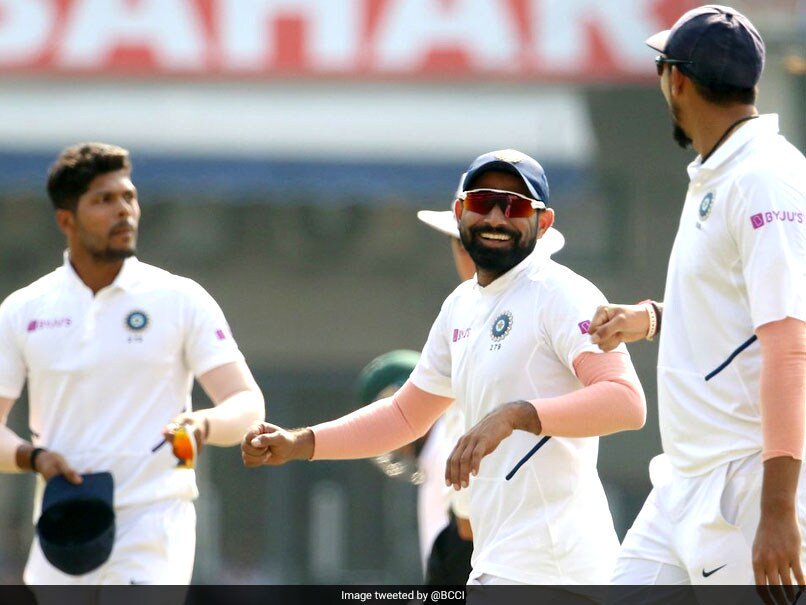Shami and Ishant - A guidebook on two polar opposites complementing each other
As India wrapped up the proceedings in Indore, Harsha Bhogle caught up with three pacers for an interview with host broadcaster Star Sports. Shami was in a “chatty” mood and initiated a free-whelming chat, something that came out as a delightful conversation - extremely rare by Indian cricketers.

It is redundant to talk about how effortlessly the Indian pacers have shifted the paradigm, making the team a pace-bowling powerhouse, hitherto unseen and unimaginable. While bowling, they run into each other, ready to share a thing or two. When celebrating, they do pump the highest for their partners and when having fun, they pull each other’s legs, giving the team a happy look. But for me, it was the camaraderie during the interview that struck a chord.
Taking no credit away from the brilliant moderation by the very excellent Bhogle, the no-holds-barred unfiltered interview was down to the happy space they are in. After all, this is an Indian team that doesn’t want to play the blame game or wants to pull someone’s leg to seize the spot in the side. It is a side that can go and get into any place and make it their territory with the sheer power of understanding the craft and pushing each other to the limit.
This craftiness and moreover, the ability to latch onto every given chance has given this Indian side an incisive sting and while Umesh Yadav has been the epitome of everything excellent about bowling in Indian conditions, Mohammed Shami and Ishant Sharma have made themselves partners-in-crime that the world is jealous of. See, we haven’t taken the name of that pacer from Gujarat yet.
It is real. It is stunning and unimaginable. But how did this come about? Was it all down to mentality change and as Ravi Shastri would say, “taking the pitch out of the equation” or a careful attempt at rectifying the wrongs that haunted Indian cricket for long? The one thing that comes to my mind is plain and simple - now the bowlers understand what they are good at and how they can be benefitted from others than just stepping onto the plate and creating a needless competition of sorts. It is all down to clarity they have which has compounded with the skill to help India have a team that is laying down a marker for the performance in Test cricket.
Take Mohammed Shami for example. He is a bowler with a high-level of skill but often criticised for his lack of discipline in bowling longer spells but put Shami in a testing condition, and he would revel. What was most impressive about Shami that he bowled more dirty overs than anyone else but that could hardly bring defiance to his wicket-taking spree. Since January 2018, only Pat Cummins and Stuart Broad, among pacers, have bowled more balls than Shami. That he was on the park all along is a testament to his growing lethality, and his fitness levels, which, in the past, was all but fragile.
Ishant, for little fault of his own, had been deceived by the idea of bowling full. It might be a viable tactic in conditions like South Africa and England, but bowling full would be met with harmless drives upfront in the sub-continent. However, Shami, with his upfront seam position and the ability to move the old ball into the right-handers, has ensured that not a single batsman would have the measure of him once the wicket tears away a bit.
By attacking the length, Shami draws the batsmen forward - as we have seen in Faf du Plessis and Temba Bavuma dismissals in the South Africa series or the Mohammed Mithun and Mushfiqur Rahim dismissals in Indore - his wicket-taking pattern has everything conventional pace-bowling in India is not about. It slants in from an angle, pitches quicker and as the batsman applies the accelerator on the trigger, he either gets castled or finds the inside edge.
If the Shami way is unique, then Ishant has developed a completely different skill-set of his own to tackle the absence of Jasprit Bumrah. Sure enough, he bowls full, but that is complemented by regular dose of an inward-facing seam, making the batsmen dance at their peril. After a bad opening over in Indore, in which he was completely all over the place, Ishant put up an exhibition of sorts through a regular conventional swing pattern with occasional deliveries holding their line. It added extra pressure on the batsmen, and the inability to cut loose forced them out of their comfort zone.
While Ishant’s second-coming has brought many fans for him, one reality has often lost in time that he is not really a swing bowler. Like Stuart Broad, his strengths were his height and the high-arm action, two traits that ensured he got extra bounce from the surface. As the muscle memory of a bowler won’t allow a primarily inswing bowler to hold the seam upright at the point of release, Ishant had ended up delivering a lot of cross-seam stuff, which, in hindsight, can be argued as his biggest kryptonite in the past.
The Delhite has changed that, and with Shami being more confident as a bad-wicket bowler, Ishant found his calling card. With a fairly smooth action, Shami does the exact opposite of what Ishant is doing now - bowling full but taking the scambled seam out of the equation. It is all in the movement and trying to remind all the good things - his disciplined bowling in Test cricket - which made MS Dhoni and now Virat Kohli a solid backer of his work ethic. It has become a blessing for the overall impact on the game, and India have found a pace attack that is set to rule the roost at least for another three years.
Cricket FootBall Kabaddi
Basketball Hockey
SportsCafe

Comments
Sign up or log in to your account to leave comments and reactions
0 Comments